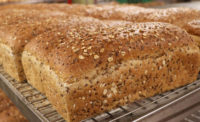Online exclusive: Developing breads, buns and rolls to meet top U.S. foodservice trends

The bread, buns and rolls used to create sandwiches across the U.S. restaurant industry maintain a strong correlation to prevailing trends. Datassential, Chicago, notes that brioche has been one of the fastest-growing sandwich carriers over the past four years, up 97 percent. Pretzel buns also continue to trend forward and grew 24 percent over that period.
When it comes to menu item descriptions, language matters. “Some of the fastest-growing carriers in the past year take the options that are already trending to the next level with descriptors that evoke artisan craftsmanship or an even more-premium connotation,” says Mike Kostyo, trendologist, Datassential. “We're seeing a rapid growth in terms like ‘butter croissant,’ ‘honey wheat’ and ‘buttermilk biscuit’ on menus.”
When we filter our data on the most-innovative restaurants across the country, we also see fast growth in potato rolls, notes Kostyo.
Foodservice operators and manufacturers are discovering the benefits of potatoes for bread baking, says Rachael Lynch, global marketing manager, Potatoes USA, Denver. “Potatoes function as a complement to wheat flour, or a replacement to wheat flour in combination with other gluten-free flours. When used in breads and baked goods, dehydrated potatoes offer functional benefits, including a softer texture, longer-lasting freshness and better browning capabilities.” She also notes that potatoes also act as a natural dough conditioner, making the yeast easier to handle for improved machinability.
Kostyo also notes strong growth for Texas toast, pumpernickel bread, marble rye when used as sandwich carriers.
Ethnic interest
“All of the fastest-growing sandwich options on menus are globally inspired, with the top spots taken by the torta (430 percent growth over the past four years), tartines (up 93 percent), bánh mì (up 40 percent), croque monsieur (up 26 percent), croque madame (up 25 percent) and Cuban sandwiches (up 21 percent),” says Kostyo. “So the market is certainly growing for carriers that lend themselves to these sandwiches.”
Globally inspired sandwiches, including Chinese bao and Indian flatbreads, like unleavened roti and leavened naan, generate intrigue, notes Zachery Sanders, marketing director, Ardent Mills, Denver. “Mexican tortas and empanadas are also popular.”
Artisan pita breads and naan are also seeing rapid growth, per Datassential.
Using flatbread as a sandwich carrier brings an upscale twist to menus. “Flatbreads offer consumers a more-gourmet sandwich eating experience, along with a convenient format,” says Cam Suarez-Bitar, marketing and public relations manager, Bellarise, Pasadena, CA.
Quintessential comfort food never seems to go out of style, says Sanders. “So that means good, old-fashioned white sandwich breads are re-emerging for melts and grilled cheese. Artisan breads and gourmet toppings add a grown-up twist to grilled cheese and bistro staples such as croque madame and monsieur combine sweet and savory flavors.”
Breakfast matters
Kostyo suggests that bakers should consider ways to market nontraditional carriers for sandwiches to help operators stand out and create something new, like a croque monsieur bagel.
Brioche is also a factor in morning daypart trends. When just looking at breakfast sandwiches, brioche is up 86 percent. Also, sandwiches featuring biscuits grew 50 percent over the past four years, per Datassential.
Kostyo notes that the breakfast daypart is seeing strong growth. “The overall growth of breakfast sandwiches on menus—up over 25 percent in the past four years—suggests that plenty of operators are finding ways to cross-utilize carriers across dayparts.”
Flavorful and nutritious
“For sandwiches and sliders, pretzel bread and softer, less chewy ciabatta, brioche and sweet Hawaiian-style breads and rolls continue to remain popular,” says Nicole Rees, product director, AB Mauri North America, St. Louis. “Additionally, high-quality sourdough rolls that go far enough—but not too far—in terms of level of sourness are gaining ground with consumers due to their robust flavor, moistness and resilient texture.”
Flavor and texture variations continue to be a focus, suggests Matt Gennrich, senior food scientist, R&D, bakery applications, Cargill, Plymouth, MN. “One recent example is Subway’s Sunflower Crunch bread—the sunflower seeds provide some additional protein, while also adding another dimension to the bread’s overall texture.”
Anna-Maria Fritsch, head of marketing, Fritsch Group, Idar-Oberstein, Germany, suggests that breads with more protein can have a strong marketing impact—particularly in snack-sized menu items. She recommends small sourdough buns and rolls made with long dough processing, as well as croissants specifically formulated for use as sandwich carriers.
Richard Breeswine, president and CEO, Koenig Bakery Systems, Ashland, VA notes trends like whole-grain breads, brioche and challah hamburgers and rolls, pretzel rolls of all kinds, and stamped or branded rolls. “We have customers stamping their logo into their hamburger buns, for example. The main key is to find diversity from other available products.”
The better-for-you movement is especially apparent in school foodservice, notes Gennrich. “With the focus on whole grains in the school lunch program, most bread and grain-based products are required to be at least 51 percent whole grain. Formulating bread products to contain this level of whole grain is generally not too complicated. What is more challenging is formulating a product that will be acceptable in flavor and texture. Including different types of whole grains (other than wheat), utilizing different granulation sizes and experimenting with flavors (including flavor enhancers or blockers) can all help.”
We are a nation on the go, and more than 50 percent of meals are consumed outside of the home these days, says JoAnn Rupp, global market insights manager, Corbion, Lenexa, KS. “As consumers continue to shift away from consuming three meals a day while meeting their needs for health and wellness and premiumization, many foodservice companies/restaurants are turning their focus toward offering smaller, wholesome on-the-go meals, and nutrient-dense baked goods or sandwiches featuring whole-grain or artisan bread provide a great opportunity for manufacturers to capitalize on those demands. Additionally, we’ve seen a large push for products made with whole grains, pulses and gluten-free ingredients that also meet consumers’ nutritional and convenience needs.”
Cross-pollination
Bakers should also look toward foodservice trends for retail product R&D inspirations, notes Gennrich. “Consumers do try to replicate their dining-out experiences at home, especially when they find a new format or flavor they really enjoy. Rather than always spending extra money to eat out, they may look for these items from the retail sector. Pretzel buns are a good example. They first became popular in the restaurant and foodservice space, then we saw an explosion of similar products available at retail.”
The higher quality of breads, buns and rolls seen in many restaurants today increases shopper desires for the same quality when purchasing in a retail location, says Breeswine. He suggests options like glazed brioche hamburger buns or slider rolls, crusty artisan breads, and sourdough breads.
As restaurants continue to offer more artisanal-style breads, retail demand has increased, says Rupp. “Today’s consumers are also looking for ways to bring ethnic experiences to their homes. As a result, we are also seeing a large demand for flatbreads, tortillas and pita breads in retail bakery.”
For more on the current market for breads, including key trends, see “Top bread trends to drive category growth.”
Looking for a reprint of this article?
From high-res PDFs to custom plaques, order your copy today!







